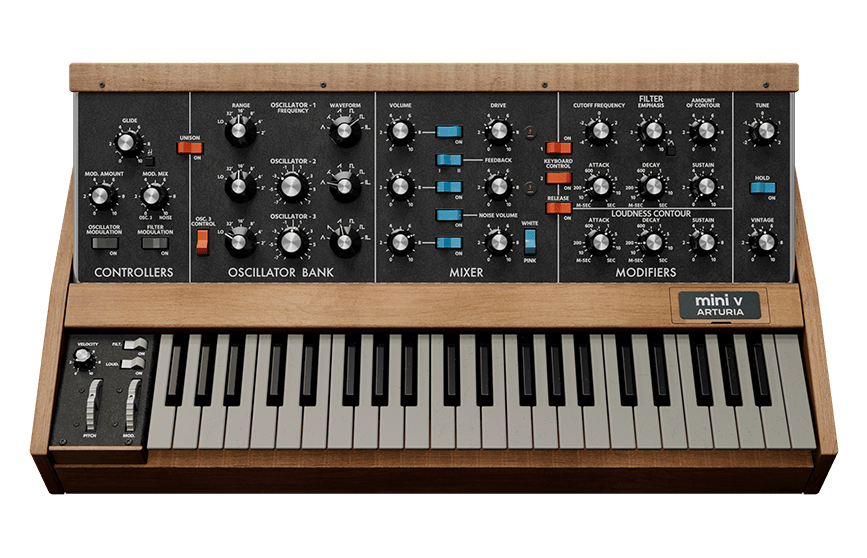Arturia Minimoog V Crack Mac
Jan 28, 2019 Jup V-8 is a powerful addition to the family Arturia analog synthesizers. Offering the unique sound palette of the Roland Jupiter 8, this virtual version is the dream of every sound designer. Jup V-8 is a powerful addition to the family Arturia analog synthesizers. Offering the unique sound palette of the Roland Jupiter 8, this virtual version is the dream of every sound designer.
Although we only reviewed this Minimoog-emulating software instrument four months ago, Arturia have now thoroughly redesigned it, taking into account many of the points made in the original SOS review. So let's take a second look. Like you, I'm an enthusiast. I love keyboards, synthesizers, recorders, effects, and anything else that allows me to impose my musical ideas on anyone careless enough to listen.
Since the early 1970s, I've wanted every piece of equipment I've owned or played to sound great and do everything that it promised. Sometimes I've been happy, other times frustrated, and it pains me when something fails to live up to expectations. Furthermore, I take no delight in expressing that dissatisfaction, particularly when I know that the people involved have tried hard to develop a good product and market it at a competitive price. So when I reviewed Arturia's Minimoog V (or MMV) earlier this year, I really wanted it to be superb.
Unfortunately, a number of serious problems presented themselves, so I described these as fairly as possible, and thought that was that. However, following the publication of the review, the people at Arturia got in touch. They explained that they were working on a new version which they hoped would address many of the points that I (and others) had raised. The result is version 1.5; a free upgrade from.
So, did Arturia get it right this time? Let's find out. It's simple to obtain v1.5 — you just click on a link at the above-mentioned page on Arturia's site. Once you've downloaded and run the installer, you will be prompted for the original CD, and once you've inserted this (a sensible anti-piracy precaution), the new version will appear soon after.
At first sight, it appears that v1.5 is installed alongside earlier versions, but this is not the case. Although my Powerbook now has folders containing v1.0, 1.1 and 1.5, it invokes the v1.5 audio engine no matter which front end I launch.
Happily, this addresses the same user files as the earlier versions, so patches created on v1.0 and v1.1 are immediately available in v1.5. On the other hand, some significant changes to Minimoog V 's oscillators and filter mean that these patches do not always sound the same on the new version.
Download century iib autopilot manual free. All of which brings us neatly to. When testing the sounds of the oscillators in v1.1, I found that the square wave sounded much 'hollower' than on my Minimoog. This was because Arturia's wave was too close to the ideal; real Minimoogs produce non-ideal square waves with duty cycles that are not exactly 50 percent.
In MMV v1.5, the square wave has been modified, and its default duty cycle is now 48 percent. The result is that the sound is amazingly close to that of my Minimoog, from the bottom of the keyboard at 32' to the top at 2'. Nonetheless, if you want perfect square waves, you can have them. As I noted in March, Minimoog V allows you to adjust the duty cycles of its pulse waves, so the choice is yours. A more significant problem in v1.1 lay with the ramp+triangle wave, which was very different from that of the Minimoog itself. The improvement in v1.5 is clear to hear and to see — see the three graphs below. The first of these shows the ramp+triangle from my Minimoog, while the second shows the same wave produced by Minimoog V version 1.1, as reviewed in March.
The third graph is the same wave from the updated MMV v1.5, and as you can see, it's all but identical to the real thing. Sonically, the improvement is remarkable. The ramp+triangle from the author's Minimoog. Here's the same wave produced by Minimoog V version 1.1.
This third graph is the same wave from the updated MMV v1.5, and as you can see, it's all but identical to the real thing (top). A lesser error lay in the triangle wave, which was significantly 'woodier' than on my Minimoog.
